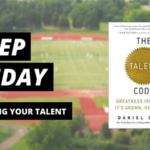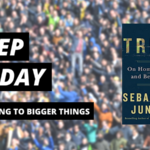This Friday I’d like to focus on ideas presented in The Inner Game of Tennis. Here’s the basic idea: There are two games always being played. Whether it’s in sports, studying, or chatting with a friend. There is the outer game which is what we see and experience outside of ourselves. And then there is the inner game which is what goes on inside of our own heads. And in the book, the Gallwey states that we need to pull away from focusing solely on the outer game and instead start inwardly by working on our inner game because that is was ultimately drives performance.
Within the inner game, there exist two Selves. Self 1 which is your conscious, thinking mind. And Self 2 which is your subconscious, doing mind. The way to win the Inner Game is to learn to listen to Self 2 over Self 1. To put your attention towards the ‘doing of action’ and not the ‘thinking of action’. This is the challenge the book presents and here are the four ways you can rep this out.
. . .
Finding Your Inner Game | 4 Rep Friday
The Inner Game of Tennis
The Classic Guide to the Mental Side of Peak Performance
By W. Timothy Gallwey

🏋️ Rep #1 – Non-Judgemental Attitude
“When we plant a rose seed in the earth, we notice that it is small, but we do not criticize it as “rootless and stemless.” We treat it as a seed, giving it the water and nourishment required of a seed. When it first shoots up out of the earth, we don’t condemn it as immature and underdeveloped; nor do we criticize the buds for not being open when they appear. We stand in wonder at the process taking place and give the plant the care it needs at each stage of its development. The rose is a rose from the time it is a seed to the time it dies. Within it, at all times, it contains its whole potential. It seems to be constantly in the process of change; yet at each state, at each moment, it is perfectly all right as it is.”
Action: In the same way you wouldn’t judge a baby who is learning to walk or a flower slowly growing, you should learn to treat your own development the same way. Without judgment. Next time you are working on improving a skill take the judgment out of the picture. Just observe.
–
🏋️ Rep #2 – The Power of Imagery
“Getting the clearest possible image of your desired outcomes is a most useful method for communicating with Self 2.”
Action: The doing part of your brain does not respond well to dialogue. It works best from imagery. In order to avoid overthinking, it’s best to rely on imagery by visualizing where you want your shot to go or what your next move should look like. Practice visualizing the movements, not explaining the movements.
–
🏋️ Rep #3 – Trust Thyself
“As long as Self 1 (thinking) is either too ignorant or too proud to acknowledge the capabilities of Self 2 (doing), true self-confidence will be hard to come by. It is Self 1’s mistrust of Self 2 which causes both the interference called ‘trying too hard’ and that of too much self-instruction.”
Action: If you know how to do something (like serving) then let it happen by trusting yourself. If you are unsure, TRUST that you will be able to learn. The ego of Self 1 wants to take credit for learning, so it’s essential that you practice quieting Self 1 and instead learn to trust/listen to your doing part of the brain.
–
🏋️ Rep #4 – Relaxed Concentration
“The player of the inner game comes to value the art of relaxed concentration above all other skills; he discovers a true basis for self-confidence; and he learns that the secret to winning any game lies in not trying too hard.”
Action: The challenge of practicing relaxed concentration is that even though you want to focus on Self 2, Self 1 always wants to be involved. So, to give the thinking mind something to focus on applying the “Bounce Hit” strategy. In tennis, this means you internally say “bounce” when the ball bounces and “hit” whenever you hit the ball. Find a way to apply this practice to your sport.
. . .
I could honestly go on for days with this book. There are mental reps you could apply on nearly every single page. Instead, I wanted to focus on these 4 main concepts. Non-Judgement, Imagery, Trust, and Concentration. If you are looking for a better way to train and quiet down that inner critic, I cannot recommend this book enough. It’s a shorter read, but packs in nothing but valuable ideas and practices.
Learn More:
5 Key Take Aways: Video
Inner Game of Coaching: Video
Bounce Hit Explanation: Video
Buy the Book: The Inner Game of Tennis
. . .
SUMMARY
🏋️ Rep #1 – Non-Judgement
Action: Judge yourself like a baby learning to walk.
🏋️ Rep #2 – Imagery
Action: Don’t think about your movements, see them.
🏋️ Rep #3 – Trust
Action: Trust that you know or are capable of learning to know.
🏋️ Rep #4 – Concentration
Action: Apply the Bounce Hit to your sport. Let the doing mind (Self 2) take over.
Thanks for stopping by the Daily Athlete Gym 💪🧠
See you next Friday!
If you find this post helpful, useful, insightful, or in any way practical, please like 👍 and share it wherever you found it. You’d be helping me out big time and it gives more people a chance to read it as well. Thanks.
– Derek



